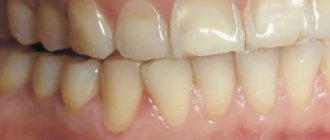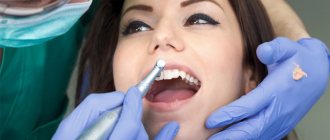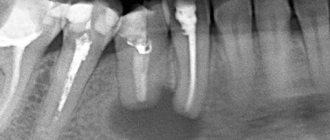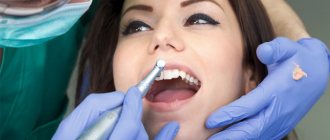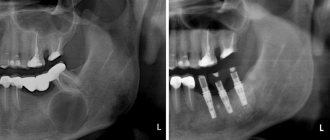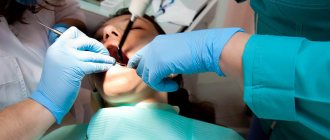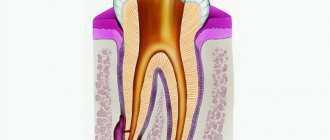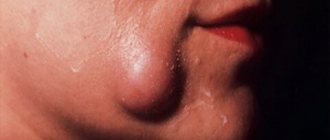An oral mucosal cyst (also called a mucocele or mucocele) is a small capsule filled with fluid. According to dentists, such cysts are generally harmless and painless, but they can cause discomfort because they feel like a foreign object.
Mucoceles usually occur on the inner surface of the lips, but can also appear on the tongue, palate, buccal mucosa, and floor of the mouth. These cysts also form around tongue or lip piercings. A cyst on the bottom of the mouth is called a ranula, and on the gum - an epulis. Mucous cysts are bluish in color and filled with clear fluid. The dentist usually recognizes them at first sight.
Tonsil function
The tonsil is a lymphoid tissue located in clusters in the pharynx. The tonsils are one of the organs of the immune system that protect the internal environment of the body from harmful influences. There are six tonsils in the human pharynx: two paired and two unpaired; together they form the so-called Pirogov-Waldeyer protective ring. The palatine tonsils (popularly called tonsils) are located closest to the entrance of the pharynx, and these tonsils suffer more often than others. The lymphoid tissue of the tonsils supports general and local immunity. Lymphocytes mature in it and antibodies are produced.
The palatine tonsils play a vital role. They are the largest and differ in their structural features. Upon careful examination, it is clear that the surface has depressions or lacunae, smoothly turning into crypts or deep folds lined with mucous membrane. Only the lateral surfaces are covered with a capsule of connective tissue, and all the rest are in contact with everything that enters the pharynx.
At CELT you can consult an otorhinolaryngologist.
- Initial consultation – 3,000
- Repeated consultation – 2,000
Make an appointment
Other formations
In addition to cysts and papillomas, there may be other benign formations in the throat that cause discomfort. These may include adenoid vegetations, otherwise called benign adenoid hyperplasia, Thornwaldt's disease.
Treatment is usually surgical. If the cyst is large, it is removed and cleaned, it is completely enucleated. If the brush is small, there are two methods. One is with the help of a laser, when the tissue is evaporated. The second is with the help of cryotherapy, when the tissue is burned, a scab is formed, which later falls off as a scab.
Classification
Experts distinguish two types of tonsil cysts:
- Retention - formed after blockage of the ducts of the glands of lymphoid tissue, have a classic round shape, a thin capsule, filled with serous or purulent secretion. After emptying (evacuation of contents or spontaneous breakthrough), they are filled again.
- Dermoid or congenital - formed during intrauterine development, inclusions of embryonic tissue are always found in them. These true tumors, caused by genetic causes or harm suffered by the mother during pregnancy, are very rare. The capsule is usually dense and the contents are viscous.
Causes of retention cysts
The reasons for the formation of cysts are varied, but more often than others, factors such as:
- chronic inflammation of the tonsils and pharynx with periodic exacerbations - tonsillitis, pharyngitis;
- autoimmune diseases accompanied by the production of a large number of lymphocytes;
- smoking, especially tobacco with a high tar content;
- injuries, including the habit of swallowing small bones;
- hormonal imbalance;
- occupational hazards, inhalation of aggressive aerosols;
- decreased immunity, especially local.
The formation of a cyst is caused by impaired drainage of the mucous lacunae of the tonsils against the background of the inflammatory process.
How to diagnose?
A person who feels a cyst should go to the doctor. And the first question he will have to answer is when exactly he first discovered the formation. It is important. “First of all, a person looks into his own throat, takes a flashlight and tries to see if there is something. As a rule, this occurs against the background of a number of symptoms,” notes the ENT specialist.
Among the symptoms that may be accompanied by a cyst in the throat, Vladimir Zaitsev names the following conditions:
- foreign body sensation;
- dry throat;
- sensation of a lump.
Sometimes there is a situation when in a normal state everything is fine - there are no surprises, but during, for example, a swallow, a problem is very clearly felt.
Article on the topic
Cancer is not rock. How to identify cancer at an early stage It is worth understanding that a cyst or papilloma can be located deep in the throat - so that a person himself will not see it. In such a situation, only a doctor can do this. “A correctly performed examination will look like this: first the doctor will conduct a visual examination, collect complaints, and then perform an endoscopy. With the help of the device, he will be able to fully examine the formation - where it is located, size and affiliation,” says Vladimir Zaitsev.
Manifestations of tonsil cysts
Symptoms of having a palatal cyst depend on its size and location. Cysts up to 1 cm in size usually do not manifest themselves, are invisible and painless. People, as a rule, do not even suspect their existence. Cysts can be discovered accidentally during routine examinations by an otolaryngologist.
You can suspect the presence of a cyst in the tonsil if you have bad breath with healthy teeth and normally functioning digestive organs. The smell comes from food particles that become trapped in the area of the cyst and begin to decompose there. As the size of the cyst increases, a person may experience the following symptoms:
- feeling of constant presence of a foreign body in the throat;
- sore throat or discomfort;
- difficulty and mild pain when swallowing solid food;
- hoarseness of voice.
Young children may begin to choke on food. If the cyst grows towards the pharynx, then a feeling of lack of air may occur, which is especially pronounced in children whose larynx is small. The existence of the cyst itself maintains chronic inflammation. The cyst excludes areas of the tonsil from immune protection.
Signs of a cyst
Among the main symptoms of the disease:
- The appearance of an unusual protrusion on the soft tissues of the mouth. It may resemble an abscess. It usually has a bluish color with a burgundy border, but it can also match the tone of healthy gums. The “older” the mucocele, the thinner its walls become. The “bubble” is movable; it is not fused to the surrounding tissues.
- Discomfortable sensations while chewing food. There is a feeling as if there is a foreign object in the mouth that is constantly in the way.
- An unpleasant feeling of constriction of the mucous membrane. In this case, pain does not occur.
The cyst may burst if there is a lot of pressure on it. Spontaneous opening sometimes occurs while eating. The difficulty is that afterwards it forms again - through the passage in the mucous membrane, the cleared cavity is refilled with liquid contents.
Diagnosis of a cyst
As a rule, detecting a cyst does not cause any particular difficulties, since the pharynx can be clearly seen even with the help of a backlit frontal mirror. The main thing is to contact an otolaryngologist for examination. ENT doctors use various instruments during examination - spatulas, elevators, and, if necessary, endoscopes.
The cyst is determined in different parts of the tonsils, on the surface or in the depths. It has the appearance of an opaque round formation, similar to a ball, whitish in color, elastic and mobile. There may be no signs of inflammation of surrounding tissues.
You cannot touch or put pressure on the cyst yourself - it can burst, and its contents are unknown. At best, the purulent contents will enter the stomach, and at worst, it will spread to other organs.
The doctor examines cysts larger than 1 cm very carefully, without damaging the surrounding tissues, trying not to touch the capsule.
Diagnosis of a cyst includes puncture (puncture and removal of contents). If necessary, the resulting material is examined in the laboratory to understand the nature of the disease. If a malignant process is suspected or blood is leaking from a cyst, treatment begins immediately, without waiting for the end of the examination.
Depending on age, general condition and concomitant diseases, the doctor may prescribe other clinical tests. The blood coagulation system, the functioning of the heart and lungs are required to be examined.
Cyst removal
Sometimes, especially if the drained cyst recurs, surgical removal of the mucocele may be required. Complications from such interventions are extremely rare and include risks standard for surgical operations, such as infection and adverse reactions to local anesthesia. Be sure to consult with your dentist and surgeon to make sure you understand the risks.
If the cyst does not burst on its own, then if left untreated, a permanent lump may form in its place. Such bumps are harmless, but in general, if any tumors appear in the oral cavity, you should consult a dentist. It is important that he carefully examine the suspicious area of the oral cavity and, if necessary, conduct the necessary research, because your dental health is an integral part of the health of the whole body.
Our doctors
Debryansky Vladimir Alekseevich
Doctor - otorhinolaryngologist, doctor of the highest category
34 years of experience
Make an appointment
Zharova Galina Gennadievna
Doctor - otorhinolaryngologist, member of the European Society of Rhinologists, doctor of the highest category
40 years of experience
Make an appointment
Gogolev Vasily Gennadievich
Doctor - otorhinolaryngologist
20 years of experience
Make an appointment
Surgical intervention (opening a tonsil cyst)
In cases where drug treatment is unsuccessful or when the patient experiences obvious, persistent symptoms, the doctor recommends surgical intervention, which helps prevent relapses in the future.
Before opening the cyst, the otolaryngologist performs local application (irrigation, lubrication) anesthesia, opens the cyst with a scalpel and evacuates the contents. After the intervention, the doctor treats the site of the process with antibacterial drugs and prescribes antiseptic therapy.
If necessary, upon completion of the intervention, the otolaryngologist can take the contents of the cyst for analysis or material for histological examination.
If repeated cystic formations occur, the cyst refills with contents, then the most effective method is considered to be surgical intervention, i.e. complete removal of the cyst with its membranes.
Treatment of palatal cysts
Tonsil removal
- Cost: 75,000 - 105,000 rubles.
- Duration: 30-40 minutes
- Hospitalization: 1-2 days in hospital
More details
Treatment of cysts is determined by many factors, primarily the size of the cyst, its location, growth rate and the age of the patient. At first, they always try to carry out a high-quality course of conservative treatment, especially anti-inflammatory treatment. Treatment is carried out both general and local.
The radical and best way to treat cysts is surgery, which can be performed in different ways. Small cysts located superficially are removed along with the capsule. After this, a slight scar remains on the tonsil, which soon resolves.
The operation is performed under local anesthesia, the patient does not feel anything. In most cases, the intervention is performed on an outpatient basis, and the person goes home the same day.
A cyst of significant size, especially one located deeply, is removed along with part of the tonsil. If there are several cysts or the location is such that it is impossible to get to them, the tonsil is removed completely and a tonsillectomy is performed.
Treatment methods
Conservative treatment:
- washing the tonsils;
- inhalation;
- rinsing;
- ultrasonic influence;
- laser therapy.
These procedures cleanse the tonsils, increase blood circulation, have an anti-inflammatory and antiseptic effect, which has a positive effect on the recovery process of the tonsils and their proper functioning.
If conservative methods do not produce results, then surgical treatment is resorted to.
Prevention of palatal cysts
It is important to understand that a cyst is usually formed as a result of a long-term inflammatory process. Carrying a bag of pus in the throat is extremely harmful; it is a source of chronic infection. Microbes have access to the bloodstream; if the body is weakened, this can lead to diseases of the heart, joints and kidneys.
ENT doctors at CELT have extensive practical experience in treating tonsil cysts. Specialists are ready to help people of all ages, including children, as well as those who have unsuccessfully tried treatment in other clinics. The main thing is to cooperate with your doctor to complete treatment until complete recovery. You can safely contact our clinic with this problem.
Cyst or papilloma?
Cysts are different. The most common is a formation in the palatine tonsil. “For example, a person has developed chronic tonsillitis, the tissues of the tonsils are affected, plugs form in the thickness of the palatine tonsils - you can quite see them yourself by opening your mouth wider and looking into it with a flashlight. They look like an accumulation of pus,” says Vladimir Zaitsev.
At the same time, people do not know what to do with such formations. Either you need to ignore them - they will go away on their own, or go to the doctor, or try to squeeze them out on your own. There are situations when they are removed incorrectly. “And this content, which has been in the thickness of the tonsil for a long time, begins to encapsulate. This capsule is transparent, against which no one can see it, and no one can understand why the contents do not come out. It is clear that it will not come out, and a cyst will form. It may be small, but after a while it will begin to increase in size. And the more tonsillitis continues to rage, the larger it will become,” says the ENT specialist. The specialist notes that cysts can form in both one and two tonsils, which means you should not lead to polycystic disease - it is better to contact specialists as early as possible.
Article on the topic
Don't get cancer. How bad habits affect the appearance of cancer It is also worth understanding such a thing as the presence of another type of formation in the throat. We are talking about papillomas. These papillomas can occur on the soft palate, palatine tongue, and on the back wall of the pharynx. “In fact, this is not a cyst, but quite often people regard it as such - they see that the formation is whitish, and there may even be some kind of liquid in it. In fact, for a person there is not much difference. But the doctor, on the contrary, should show more attention,” notes the otorhinolaryngologist.
For the patient, the recommendation here is simple - do not try to eliminate it yourself. It is no secret that many people try to gnaw off their own papilloma, bite it off, tear it off, etc. “This is fundamentally wrong, since papilloma requires morphological examination. A cyst, in principle, too, but to a lesser extent. And the doctor must evaluate the papilloma, determine whether there is a tendency towards malignancy, whether it is cancer initially,” says Vladimir Zaitsev.
Our services in otorhinolaryngology
The administration of CELT JSC regularly updates the price list posted on the clinic’s website. However, in order to avoid possible misunderstandings, we ask you to clarify the cost of services by phone: +7
| Service name | Price in rubles |
| Taking ENT smears | 600 |
| Videoendoscopy of the upper respiratory tract | 2 400 |
| Radio wave removal of skin (mucous) neoplasms of ENT organs | 4 000 |
All services
Make an appointment through the application or by calling +7 +7 We work every day:
- Monday—Friday: 8.00—20.00
- Saturday: 8.00–18.00
- Sunday is a day off
The nearest metro and MCC stations to the clinic:
- Highway of Enthusiasts or Perovo
- Partisan
- Enthusiast Highway
Driving directions
How to get treatment:
- Make an appointment. By phone (89031830141), make an appointment from the website, by E-mail.
- Consultation. In person or remotely (E-mail, WhatsApp, Viber).
- Examination. Ultrasound of the kidneys and bladder. For proximal hypospadias or in combination with cryptorchidism - endocrinological examination.
- Hospitalization and collection of tests. Collection of necessary tests and preparation for surgery.
- Surgical treatment. Microsurgical reconstructive plastic surgery.
- Extract. Recommendations in the postoperative period.

